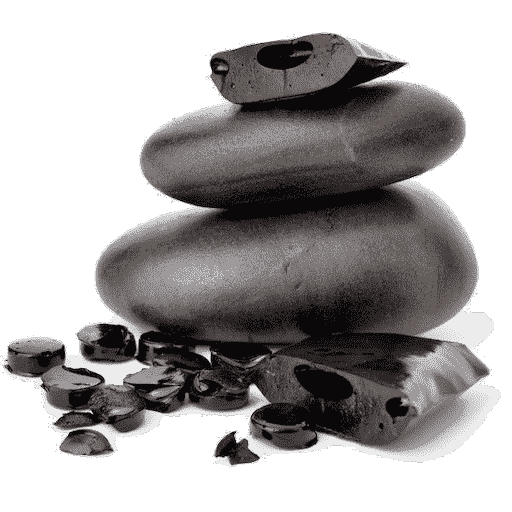Composition of Shilajit

Molecular Composition of Shilajit
What minerals does Shilajit contain?
The true composition of Shilajit has not yet been determined because of the set of components and variability of their concentration. It is known that there are macro and microelements there. Organic substances like metal oxides, amino acids, vitamins, essential oils, resins, and resinous substances are key components and they are the most easily determined. Also, such components as bee venom and various results of the decomposition of organic residues were found during the study. They are called “humic” bases in a scientific environment.

Molecular Composition of Shilajit
Organic and Non-Organic Components
When we take into consideration organic and non-organic components of Shilajit we should mention that it contains 3 times more non-organic than organic. This fact is the most beneficial to humankind.
- We find carbon, oxygen, hydrogen, and nitrogen among useful organic elements here. Shilajit does not contain them in pure form, but it contains them in the compound of resins, proteins, and acids.
- There are mostly: aluminum, magnesium, potassium, sodium, calcium among non-organic elements.
- What is more lots of useful rare-earth elements like chromium, barium, strontium, cesium, rubidium, etc. were found.
Some of them are presented in a very small concentration. But even this level of concentration is sufficient for a favorable and restorative effect on the human body.
Physicochemical properties
Purified from impurities and extracted shilajit is a homogeneous mass of dark yellow, dark brown, or black (sometimes there are shades of red, white, blue, and bluish, elastic consistency, with a shiny surface, a peculiar aromatic smell, and a bitter taste. – 2-2.6 g / cm³; melting point – +81 ° C; pH of a 0.5% solution – 6.7-7, during storage it rises to 7.5. term]) due to moisture loss.
Easily soluble in water (1/8), very slightly soluble in 95% alcohol (1/4500) and ether (1/7000), practically insoluble in chloroform. Contains mineral (calcium, manganese, sodium, iron, chromium, lead, etc.) and organic (solid paraffinic hydrocarbons, carbohydrates, amino acids, waxes, fatty acids, etc.) substances.
Aqueous solutions are transparent, brown in color. It contains organic and inorganic parts and contains water-soluble forms of macro-and microelements potassium, phosphorus, calcium, iron, and many others. others, organic acids (glutamic, glycemic, petroselinic, and many others). The inorganic component of shilajit can be reflected by the formula CaSi (K, Na) 5C25H5O26 with an organic component C6H6O3.
Organic, Macro, and Trace Elements
Shilajit is a potent and very safe dietary supplement, potentially able to prevent several diseases, but its main medical application now appears to come from its actions in the benefit of cognition and potentially as a dietary supplement to prevent Alzheimer’s disease. In essence, this is a nutraceutical product.
- Organic compounds – approximately 95% of the total composition.
- All other elements – 5%.
| Organic Compounds | |
|---|---|
| C | Carbon |
| H | Hydrogen |
| O | Oxygen |
| N | Nitrogen |
| Rare earth Trace Elements: | |
|---|---|
| Gb | Gadolinium |
| Ho | Holmium |
| Dy | Dysprosium |
| Eu | Europium |
| Yb | Ytterbium |
| Y | Yttrium |
| La | Lanthanum |
| Lu | Lutetium |
| Nd | Neodymium |
| Pr | Praseodymium |
| Pm | Promethium |
| Sm | Samarium |
| Tb | Terbium |
| Tm | Thulium |
| Ce | Cerium |
| Er | Erbium |
| Macro and Trace Elements | |
|---|---|
| Al | Aluminum |
| Ba | Barium |
| Be | Beryllium |
| V | Vanadium |
| Bi | Bismuth |
| He | Helium |
| S | Era |
| Fe | Iron |
| Au | Gold |
| K | Potassium |
| Ca | Calcium |
| Co | Cobalt |
| Si | Silicon |
| Li | Lithium |
| Mg | Magnesium |
| Mn | Manganese |
| Cu | Copper |
| Mo | Molybdenum |
| Na | Sodium |
| Ni | Nickel |
| Cn | Tin |
| Rb | Rubidium |
| Ag | Silver |
| Sr | Strontium |
| Sb | Antimony |
| Ti | Titanium |
| P | Phosphorus |
| Cr | Chrome |
| Cs | Cesium |
| Zn | Zinc |
| Zr | Zirconium |
Learn more – National Institutes of Health.
